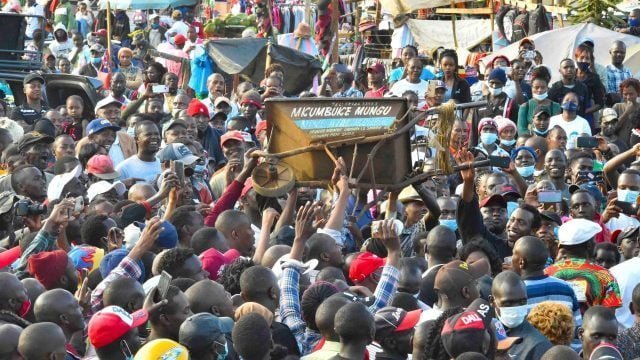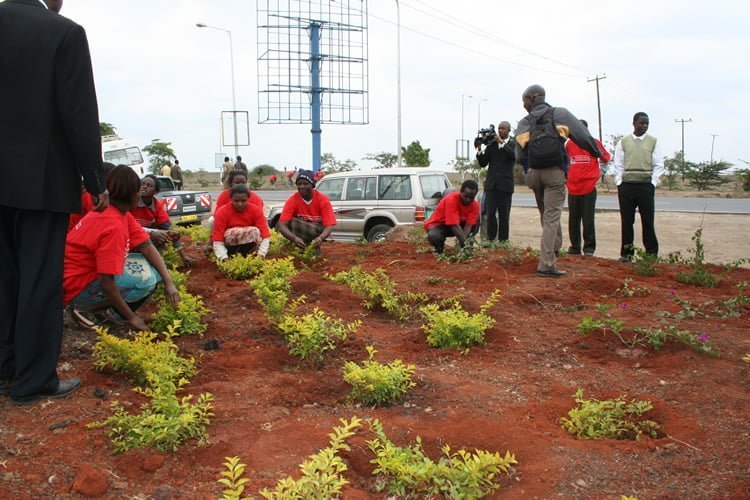Making truth powerful;
Making power truthful

With less than a year to Kenya’s 2022 general elections, the political elite are unleashing strategies in an attempt to clinch positions of power.
Political moves are furiously happening: breaking old alliances and forming new ones, jumping from one political party to another, among others. The country is back to promises mode, with political aspirants declaring the many things they intend to do should they get elected.
In recent weeks, ‘bottom-up’ and ‘trickle-down’ economic approaches have become political buzzwords. A heated debate has been brewing on the relevance of the ‘bottom-up’ approach, with its proponents citing failures of the ‘trickle-down’ approach, which they claim has been adopted by the previous regimes, to spur economic development.

Wheelbarrow used as a key symbol by proponents of the Bottoms-up economic model | Source: Daily Advent
Unfortunately, most Kenyans with limited understanding of these approaches and their impact on the economy have missed out on the debate.
To put it in a layman’s language, the ‘trickle-down’ approach entails advancing policies that favor big firms and established business entities. This is in line with supply-side economics, which ascribes economic growth to the production of goods for consumers. Some of the strategies adopted in the ‘trickle-down’ approach include tax cuts and subsidies which aim at reducing the cost of production for such entities and encourage expansion with the value trickling down to the masses in the form of employment opportunities.
Development economists have demonstrated that the ‘trickle down’ approach only benefits a few and by-passes the vast majority of hardworking and vulnerable segments of the population. For instance, it has been proven that tax cuts and subsidies do not necessarily spur economic growth in the long run. In as much as they promote investment and business expansion, the government still needs tax revenue from the masses to finance its spending.
Over the years, the Government of Kenya has maintained a constant corporate tax rate while using tax credits and incentives such as Export Processing Zones and Special Economic Zones to encourage investment. It is only in 2020 that the government imposed temporary tax interventions such as a cut in VAT and corporate tax to help cushion citizens from negative effects of the Covid-19 pandemic. Also, since 2013, the government has accumulated a huge amount of public debt, justified by the need to finance development projects – largely infrastructure and energy investments expected to reduce the cost of doing business and make the investment climate friendlier. The logic is that this spurs production, increases aggregate demand and hence drives economic growth. Such tax measures, public debt mechanisms and other related economic policies implemented in the past have given the impression that the Government of Kenya implements ‘top-down’ or ‘trickle-down’ economic approaches.
On the flipside, the ‘bottom-up’ approach entails formulation of policies that empower ordinary citizens, especially working-class segments of the population, directly by providing them resources that improve their livelihoods. The ‘bottom-up’ approach emphasizes empowerment of low and middle-income sections of the population, unskilled labour force and the youth. In a nutshell - utilizing the potential of low and middle-income sections of the society to drive and support the economy.
However, a peek into economic policies and programmes pursued by the Government of Kenya at least over the past two decades indicates that the government has invested substantively in what may be considered ‘bottom-up’ approaches. Both regimes of President Mwai Kibaki and Uhuru Kenyatta have made efforts to empower the masses through direct development initiatives. Some of these include programs under the National Youth Service, Kazi kwa Vijana Project launched in 2009, the Kenya Youth Empowerment Program, social protection budgetary allocations and cash transfer programs targeting poor, vulnerable and marginalized populations.

Tree planting exercise under the Kazi Kwa Vijana Project | Source: Women eNews Kenya
Also, the Government of Kenya launched the Last Mile Project in 2015 targeted at connecting Kenyan households to the national network grid, particularly low-income groups living in informal settlements and isolated communities. One may argue that devolution itself is a massive bottom-up approach to economics and governance in the country. It allows the transfer of budget to the bottom-most parts of the country – wards and villages and proffers powers to ordinary citizens to determine how money devolved are spent.
Going by definition of the models and the nature of the development initiatives designed by the various regimes, elements of the ‘bottom-up’ model have all along been practiced in Kenya. Beyond the ongoing political rhetoric, it is clear that Kenya has pursued the ‘bottom-up’ approach in many ways – especially through budgetary allocations and special programmes.
In my view, the problem has not been about what economic model to pursue but rather the effectiveness of delivery. In both cases - where the government has pursued ‘trickle-down’ or ‘bottom-up’ policies, they have been undermined by corruption, poor economic planning and politicization. These vices are to blame and not necessarily the economic model adopted. The journey to attaining a strong economy begins by eliminating these vices. This country does not need sweet promises of the political elite. All the country needs is a functional government which affects what it has been mandated. The decision to have such leaders lies with the citizens. It is high time that we make sober decisions and not be swayed by cheap and deceptive political elite.

With less than a year to Kenya’s 2022 general elections, the political elite are unleashing strategies in an attempt to clinch positions of power.
Political moves are furiously happening: breaking old alliances and forming new ones, jumping from one political party to another, among others. The country is back to promises mode, with political aspirants declaring the many things they intend to do should they get elected.
In recent weeks, ‘bottom-up’ and ‘trickle-down’ economic approaches have become political buzzwords. A heated debate has been brewing on the relevance of the ‘bottom-up’ approach, with its proponents citing failures of the ‘trickle-down’ approach, which they claim has been adopted by the previous regimes, to spur economic development.

Wheelbarrow used as a key symbol by proponents of the Bottoms-up economic model | Source: Daily Advent
Unfortunately, most Kenyans with limited understanding of these approaches and their impact on the economy have missed out on the debate.
To put it in a layman’s language, the ‘trickle-down’ approach entails advancing policies that favor big firms and established business entities. This is in line with supply-side economics, which ascribes economic growth to the production of goods for consumers. Some of the strategies adopted in the ‘trickle-down’ approach include tax cuts and subsidies which aim at reducing the cost of production for such entities and encourage expansion with the value trickling down to the masses in the form of employment opportunities.
Development economists have demonstrated that the ‘trickle down’ approach only benefits a few and by-passes the vast majority of hardworking and vulnerable segments of the population. For instance, it has been proven that tax cuts and subsidies do not necessarily spur economic growth in the long run. In as much as they promote investment and business expansion, the government still needs tax revenue from the masses to finance its spending.
Over the years, the Government of Kenya has maintained a constant corporate tax rate while using tax credits and incentives such as Export Processing Zones and Special Economic Zones to encourage investment. It is only in 2020 that the government imposed temporary tax interventions such as a cut in VAT and corporate tax to help cushion citizens from negative effects of the Covid-19 pandemic. Also, since 2013, the government has accumulated a huge amount of public debt, justified by the need to finance development projects – largely infrastructure and energy investments expected to reduce the cost of doing business and make the investment climate friendlier. The logic is that this spurs production, increases aggregate demand and hence drives economic growth. Such tax measures, public debt mechanisms and other related economic policies implemented in the past have given the impression that the Government of Kenya implements ‘top-down’ or ‘trickle-down’ economic approaches.
On the flipside, the ‘bottom-up’ approach entails formulation of policies that empower ordinary citizens, especially working-class segments of the population, directly by providing them resources that improve their livelihoods. The ‘bottom-up’ approach emphasizes empowerment of low and middle-income sections of the population, unskilled labour force and the youth. In a nutshell - utilizing the potential of low and middle-income sections of the society to drive and support the economy.
However, a peek into economic policies and programmes pursued by the Government of Kenya at least over the past two decades indicates that the government has invested substantively in what may be considered ‘bottom-up’ approaches. Both regimes of President Mwai Kibaki and Uhuru Kenyatta have made efforts to empower the masses through direct development initiatives. Some of these include programs under the National Youth Service, Kazi kwa Vijana Project launched in 2009, the Kenya Youth Empowerment Program, social protection budgetary allocations and cash transfer programs targeting poor, vulnerable and marginalized populations.

Tree planting exercise under the Kazi Kwa Vijana Project | Source: Women eNews Kenya
Also, the Government of Kenya launched the Last Mile Project in 2015 targeted at connecting Kenyan households to the national network grid, particularly low-income groups living in informal settlements and isolated communities. One may argue that devolution itself is a massive bottom-up approach to economics and governance in the country. It allows the transfer of budget to the bottom-most parts of the country – wards and villages and proffers powers to ordinary citizens to determine how money devolved are spent.
Going by definition of the models and the nature of the development initiatives designed by the various regimes, elements of the ‘bottom-up’ model have all along been practiced in Kenya. Beyond the ongoing political rhetoric, it is clear that Kenya has pursued the ‘bottom-up’ approach in many ways – especially through budgetary allocations and special programmes.
In my view, the problem has not been about what economic model to pursue but rather the effectiveness of delivery. In both cases - where the government has pursued ‘trickle-down’ or ‘bottom-up’ policies, they have been undermined by corruption, poor economic planning and politicization. These vices are to blame and not necessarily the economic model adopted. The journey to attaining a strong economy begins by eliminating these vices. This country does not need sweet promises of the political elite. All the country needs is a functional government which affects what it has been mandated. The decision to have such leaders lies with the citizens. It is high time that we make sober decisions and not be swayed by cheap and deceptive political elite.
